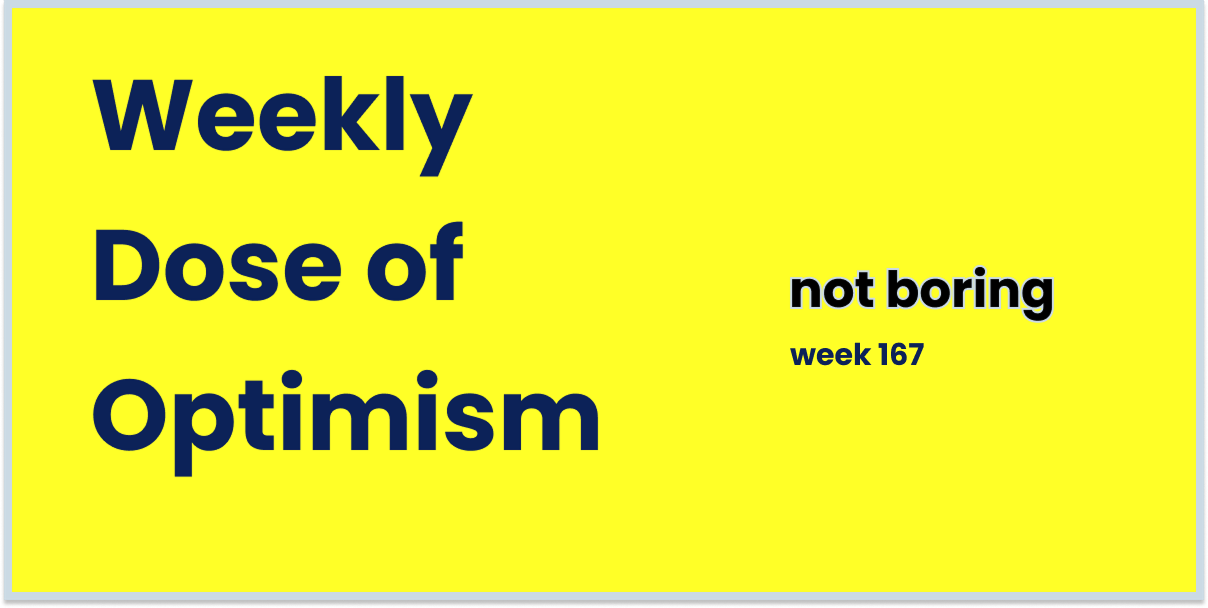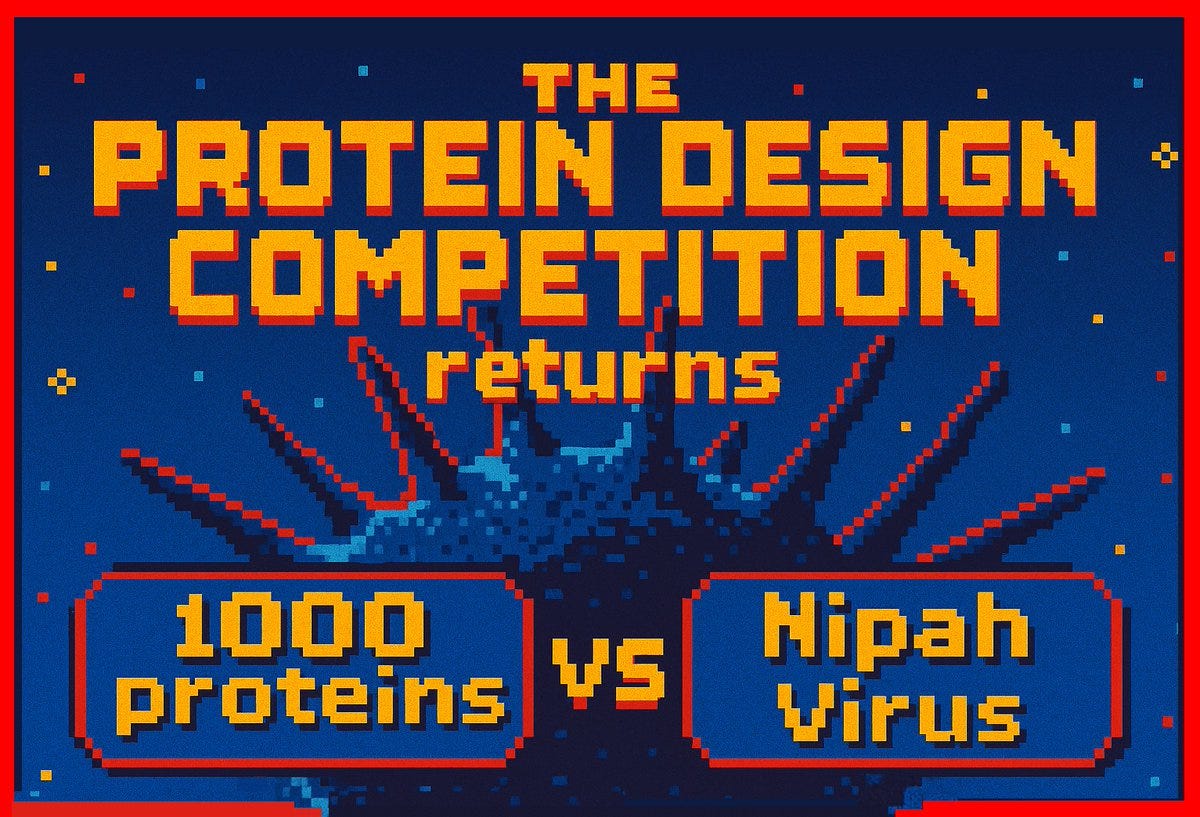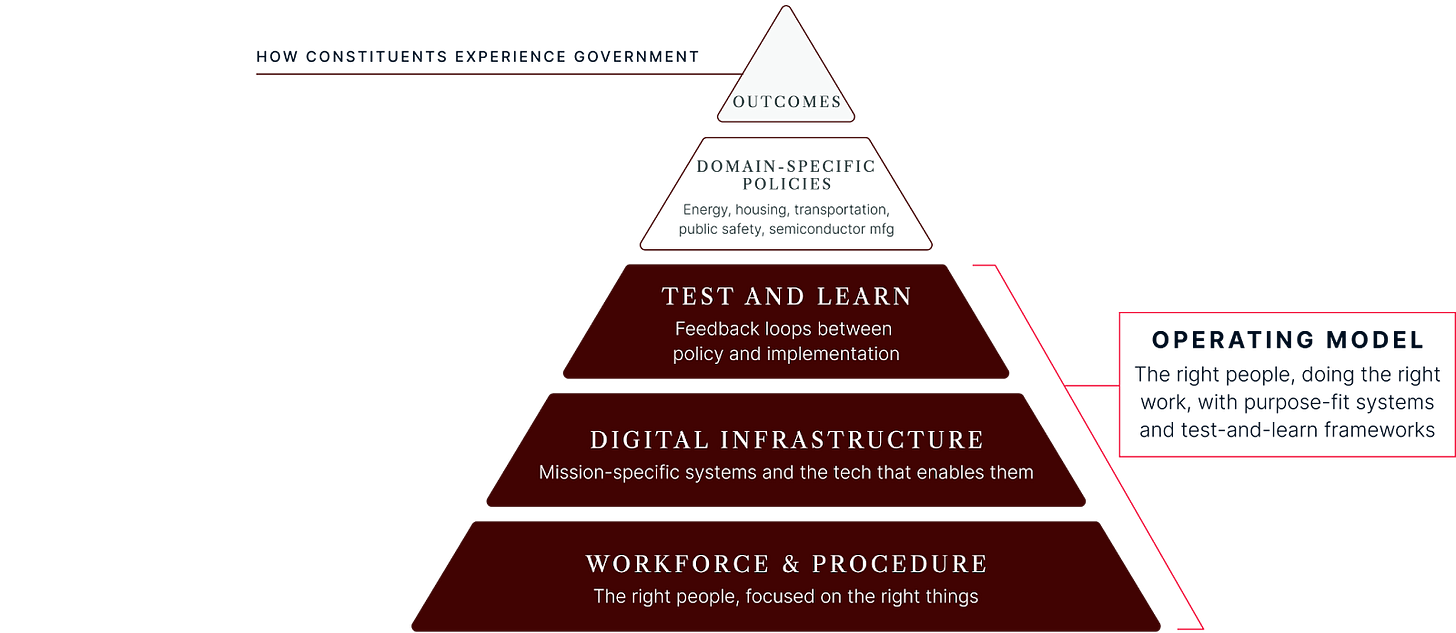Weekly Dose of Optimism #167
Science v Blindness, Google Quantum, Nucleus & Anthrogen Models, Apex Interceptors, Recoding America + Composer AI & Guardian of Liberty
Hi friends 👋 ,
Happy Friday!
Even AWS breaking the internet couldn’t stop another ridiculously packed week. The doc that Aman and Sehaj prepared had a whopping twenty-one stories competing for just five spots (and a bonus or two).
The winners were blindness cures, quantum leaps, bio models, and a new state capacity fund. I’ve included some of the ones that we left on the cutting room floor at the end of the email.
Let’s get to it.
Today’s Weekly Dose is brought to you by… Stripe Startups
Every venture-backed company — yes, you — should work with Stripe Startups.
Stripe’s mission is to increase the GDP of the internet, and it’s working. Last year, 1.3% of global GDP flowed through Stripe, over $1.4 trillion and growing. 78% of the Forbes AI 50 use Stripe’s financial infrastructure to monetize faster, experiment with pricing, and grow revenue.
As I wrote in my original Deep Dive, Stripe’s strategy from the earliest days has been to make it as easy as possible for startups to begin accepting payments, and then grow with them as they get really big. Little companies become big companies become public companies.
With Stripe Startups, they’re making it even easier.
Stripe Startups is the company’s new program designed to support early-stage, venture-backed businesses as they build, iterate, and scale. Founders enrolled in Stripe Startups get access to credits to offset Stripe fees, expert insights, and a focused community of other founders building on Stripe.
You’re going to use Stripe anyway. Get the white-glove experience.
(1) People with blindness can read again after retinal implant
Nature re: Science Corp’s PRIMA; Video from Abundance Institute
The clinical trial, which is described today in The New England Journal of Medicine1, involved 38 people with advanced AMD whose retinas had degenerated severely. One year after device implantation, 80% of participants had gained a clinically meaningful improvement in their vision.
Restoring sight to the blind is Bible-level miracle stuff, and this week, humans did just that.
A team of researchers published results of a study using Science Corporation’s PRIMA Visual Prosthesis to attempt to restore sight in legally blind adults. The PRIMA system, detailed in a recent New England Journal of Medicine study, involves a tiny wireless retinal implant, thinner than a human hair and surgically placed under the retina, paired with camera-equipped smart glasses.
The technology targets patients with advanced age-related macular degeneration (AMD), specifically geographic atrophy, which causes central vision loss leading to legal blindness. The glasses capture and process visual information, projecting it as near-infrared light patterns onto the implant, which then stimulates remaining healthy retinal cells to relay signals to the brain, effectively bypassing damaged areas. It’s like fixing a hardware problem with better software.
In a one-year clinical trial involving 38 patients, 80% showed meaningful visual acuity improvements, with many regaining the ability to read sentences, recognize faces, and perform tasks like crossword puzzles, all of which were previously impossible for them.
In the video he did with Abundance Institute, Science Corp CEO (and Duke grad) Max Hodak, said that this is just the visual prosthesis is the technology that’s furthest along in the company’s portfolio, but the brain is a big place with big responsibilities, and Science has a lot more to come.
I really like this framing Max gave on BCIs:
All engineering, in some sense, is about manipulating reality.
We’re building things. We’re making the world different than it was before. Whether this is with controlling electrons in electronics or optics or building cars or planes. This is all about kind of changing the world as it exists out there.
But you can imagine inverting this and changing the world as it exists in here.
And that is a very different way of thinking about the future.
There is nothing in the universe (that we know of) more wondrous than the human brain. I’m personally very excited to see how much more it has to offer than we realize.
(2) Google Makes Quantum Leap with First-Ever Verifiable Quantum Advantage
Hartmut Neven and Vadim Smelyanskiy for Google
What are they putting in the water in Mountain View?!
As we’ve covered, Google DeepMind is putting out the most fascinating and real-world-useful models of any of the big labs (see: last week’s model that does novel cancer science) and now, its Quantum Echoes algorithm achieved verifiable quantum advantage.
The “advantage” is that it performs the same calculations 13,000x faster than a classical supercomputer can. The “verifiable” means that other quantum computers can independently verify the results. Results were published in Nature.
In a proof-of-principle experiment, in partnership with researchers at UC Berkeley, Google “showed how our new technique — a ‘molecular ruler’ — can measure longer distances than today’s methods, using data from Nuclear Magnetic Resonance (NMR) to gain more information about chemical structure.”
This is the first of many such experiments the company will run. In its blog post, it mentions drug target binding and materials science for polymers, batteries, and “even the materials that comprise our quantum bits (qubits).”
To be clear, this is quantum, so we’re talking years away from anything useful, but this was apparently impressive enough for Elon to reply to Sundar, “Congrats. Looks like quantum computing is becoming relevant.”
When Google said its mission was “to organize the world’s information and make it universally accessible and useful,” it meant all of it, even the stuff in the physical world, and even the stuff in the physical world for which we don’t currently have information.
Hilariously, on the same day, the WSJ reported that non-Google Quantum companies are trying to give the government equity in exchange for federal funding.
(3) Big Week for Bio Models: Nucleus’ Origin & Anthrogen’s Odyssey
Origin predicts human longevity from embryo DNA more accurately than any model ever built. And it’s open-weighted. - Kian Sadeghi, Nucleus Genomics
Odyssey enables scientists and researchers to generate and edit proteins, the workhorses of all life on this planet, towards specific functional ends—scaled to over 102 billion parameters. - Ankit Singhal, Anthrogen Bio
One thing DeepMind seems to understand better than the other frontier labs is that AI seems to be particularly useful for handling biology’s complexity and scale in a way that humans can’t, really. Startups understand that, too, and two announced the results from very useful bio models this week.
Anthrogen, an “AI-research lab building a complete network for biologics discovery and development,” released Odyssey, a multi-modal protein generation engine.
According to the company, it is the most powerful biological model ever created, which is a statement I don’t know how to evaluate (although 102 billion parameters sounds like a lot), but what I find particularly cool in the announcement post (which is well-written, clear, and worth reading) is that “it allows us to rationally design and optimize proteins toward multi-objective goals--for example, ‘binds the target,’ and ‘low side effects,’ and ‘manufacturable at scale.’” Type some words, get proteins that do what you need them to do.
Ultimately, the company wants to design molecular machines with the precision that we can design regular machines today, similar to the vision that Elliot Hershberg laid out in Atoms Are Local, and having bought into that vision from the second I read his essay, I am pumped that we’re one snall step (and giant model) closer.
Very cool stuff. Now let’s see it win the 2025 Protein Design Competition and defeat Nipah Virus.
Meanwhile, Not Boring Capital portfolio company Nucleus Genomics released (and open-sourced) Origin, “disease models trained on 1.5M genomes combining 7M genetic markers.” The model predicts human longevity from embryo DNA by predicting age-related diseases like heart disease, cancer, and diabetes, across ancestries.
Using these models, families going through IVF will be able to select embryos that have a lower likelihood of contracting age-related diseases and a higher likelihood of living longer. Obviously, none of that is guaranteed, but Nucleus’ are the most accurate predictors developed to date and give parents one more tool in the toolkit they bring to bear to give their kids healthier, happier lives.
(4) Apex Unveils Project Shadow
Today, we unveil Project Shadow — Apex’s on-orbit Space-Based Interceptor (SBI) technology demonstration, launching NET June 2026.
It would be an unbelievable shame if humanity were to come this far - blindness cures, the ability to design proteins with words, healthier babies, maybe even quantum computers - only for us to blow each other up with nuclear weapons.
Fortunately, Los Angeles startup Apex is putting up its own cash to develop and demonstrate space-based interceptors, which would identify missiles and shoot them down before they could do any real damage. The plan is to show that they work, on a commercial budget and timeline, in order to get selected to be a part of President Trump’s Golden Dome.
What’s interesting about this is that Apex’s typical model is to develop satellite buses on top of which others can build whatever capabilities they need. In this case, Apex is taking it a step further and proving out that their buses work for interceptors. The plan, according to SpaceNews, seems to be to show that it works, and then partner with the Pentagon’s current missile defense contractors to do the ultimate intercepting.
This is very sci-fi stuff, which I love, but I hope that we end up spending billions of dollars on a bunch of interceptor satellites that never need to be used. Having read Anni Jacobsen’s terrifying Nuclear War: A Scenario last year, I’ll just sleep a little better at night knowing that someone is watching over us.
(5) Recoding America Announces $120 million Fund for State Capacity
Jen Pahlka via Santi Ruiz
Whether your priority is national security, economic and technological dynamism, protecting the vulnerable, or simply getting basic services to work, none of it is possible without a government capable of executing on its goals. The time for incremental fixes has passed. Let’s build the government our future demands.
For any of the stuff we write about to happen, we need either no rules (risky!) or strong state capacity.
This past weekend, at the Progress Conference, I got a chance to see Jen Pahlka speak about what the government can do, what gets in the way, and how she was planning to fix it. A few days later, she publicly announced her $120 million Recoding America Fund to help rebuild state capacity to match modern challenges and opportunities.
Jen is awesome. In 2010, she founded Code For America to help the government harness technology, served as U.S. Deputy Chief Technology Officer under Obama in 2013-2014, and helped found the United States Digital Service after leaving that role. In 2023, she wrote a book, Recoding America, and now, she has $120 million to fund activities to turn the book’s recommendations into action.
Some people think the best thing we can do if we want progress is to get the government out of the way. Pahlka, on the other hand, advocates for state capacity and thinks the government can be a force for good if it can clear out the kludge. Tie policy choices to how they’ll be implemented. Procurement reform. Civil service and hiring reform. Rule and process simplification. Better, cleaner technological systems. She talks about the thousands of pages of unread rules weighing down regulation, and the dozens of “sources of truth” underlying the IRS. Cleaning all of that up will mean that whatever policies the American people vote for, right or left, they’ll be implemented faster and less wastefully.
The fund aims to help government:
Attract + retain the right people
Task them with the right work
Via purpose-fit systems
And test-and-learn frameworks
Getting the government to function efficiently may be a bigger challenge than commercial fusion power, restoring sight to the blind, or useful quantum computers, but I’m happy Jen is on the case.
BONUS: Composer Launches AI for Trading
From Ben Rollert
Allow me to do a little proud-posting about my friend Ben and portfolio company, Composer, which launched one of the best AI products I’ve seen yesterday, one that marries what humans do well with what machines do well.
I really love Composer.
It’s been one of my favorite products for years. My portfolio there is doing really well because I don’t trade it (I’m a terrible trader). Ben is a good friend; we worked together at Breather. And it was one of the first startup investments I made.
Without understanding Composer, or having used it, I think it’s easy to dismiss this announcement as another “AI for trading” thing. I roll my eyes at most “AI for X” announcements, personally. But Composer has spent five years building infrastructure that is perfect for the moment: the ability to build, backtest, and execute strategies through if-then instructions. The idea of trading strategies instead of single names is different than anyone else does it. And I think it’s the right vector for AI trading.
Composer’s AI doesn’t try to be the best stock picker, or to replace the human. It just takes the ideas in your head, translates them into strategies, and executes trades in line with the strategies. It makes more sophisticated trading available to anyone with good ideas.
If that sounds like you, you should give it a try. It’s very cool to watch text go to backtest go to a strategy that you can trade with the push of a button.
Ben thinks about the world differently than anyone I know, and I think that this product shows that off better than anything he’s built yet. Proud of him.
DOUBLE BONUS: Atelier Missor Unveils Guardian of Liberty
Look at this beauty. Atelier Missor, who I highlighted in The Great Differentiation, shared a picture of their newest statue, Guardian of Liberty, absolutely towering over the team. This, apparently, is a scale model. The real one will be “gigantic, the tallest statue in the West.”
Les garçons plan to finish the gigantic version in a year, if they can get their visas. To me, that looks like the work of extraordinary aliens. Let’s make it happen.
Cutting Room Floor
Have a great weekend y’all.
Thanks to Stripe Startups for sponsoring. Love you, Stripe.
We’ll be back in your inbox next week.
Thanks for reading,
Packy






So stoked for Pahlka’s new endeavor. Optimism indeed (as with all the other cool items)!
Great update this week!